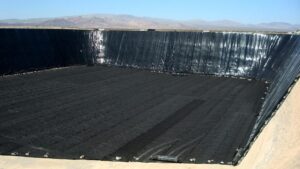Geomembrane refers to thin, flexible, prefabricated sheets made of polymeric materials used for insulating surfaces and walls. Due to their extremely high impermeability, these sheets are used in the construction and insulation of various surfaces. The raw materials used in the manufacture of geomembrane linings, such as polyethylene and PVC, have covering and impermeability properties against various fluids, which makes them very useful for lining walls, floors, and roofs of liquid collection reservoirs.
The flexibility and ready-to-install nature of geomembrane linings mean that no initial sub-base preparation is required for their installation, which significantly increases the speed of installation and commissioning. By using these linings, a very high level of reliability and performance in terms of waterproofing can be achieved, and given their lower cost compared to other usable linings, they have become a suitable and economical choice. Geomembranes can be used in the construction of various hydraulic structures. Agricultural water collection reservoirs, fish farming ponds, water and oil tanks, tunnel roofs, green roof foundations, and industrial ponds are among the cases where geomembrane linings can be optimally utilized for construction and insulation.
Geomembranes have high resistance to solar heat and also have a very high tolerance range for thermal shock, so that geomembranes can withstand temperatures up to +80 degrees Celsius and -30 degrees Celsius. Geomembranes can be installed alone or with various coverings such as concrete slabs or gravel. Among the applications of this product are its use for improving the quality of old dams, insulation, preventing leakage in the bottom of tanks, and hydraulic structures.
Advantages of constructing agricultural ponds with geomembrane sheets:
- Quick and easy installation
- Significant cost reduction compared to concrete, stone, and cement
- Geomembranes have a lifespan of 20-40 years depending on environmental conditions and the project
- High thermal resistance
- High strength of geomembrane sheets against water pressure
- Availability of different thicknesses for various and high depths
- Neutrality of polyethylenes against contaminants and additives
- No adhesion of algae and moss to the walls and bottom of the pond
- Ability to repair and mend in case of problems
- Not chewable by rodents










